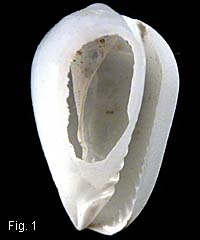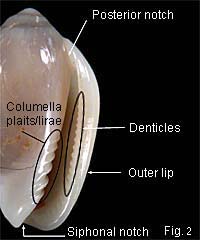|
< Previous family introduction |
|
|||||
|
Family Cystiscidae Rice snails |
||||||

|
The
Cystiscidae is a family of minute to small gastropods with
shells that are usually smooth and white, occasionally coloured, with
strong plaits on the columella. Most
species of the family are less than six millimeters in length, although
there are some larger, attractive tropical species.
The Marginellidae shares general shell appearance and features
with the Cystiscidae, and it is only recently that the two families have
been distinguished. The
Cystiscidae was separated from the Marginellidae on shell and anatomical
characters, and is considered to be more closely related to the
Olividae, while the remaining Marginellidae have more in common with the
Volutidae. There are obvious differences in the shape of the radula
teeth and the structure of the radula cartilage. There
are three major shell differences between the Cystiscidae and
Marginellidae:
Family
References Coovert, G.A. & Coovert, H.K. 1995. Revision of the supraspecific classification of marginelliform gastropods. The Nautilus 109(2&3): 43-110. Hewish, D.R. in Wilson, B.R. 1994. Australian Marine Shells. Prosobranch Gastropods (Part 2 Neogastropoda). Odyssey Publishing: Kallaroo, Western Australia. pp. 139-143 Laseron,
C.F. 1948. Laseron, C.F. 1957. A new classification of the Australian Marginellidae (Mollusca), with a review of the species from the Solanderian and Dampierian zoogeographical regions. Australian Journal of Marine and Freshwater Research 8(3): 274-311 Coverage All the named species of the family known to occur in NSW are detailed here. In some cases, such as Cystiscus angasi, it is obvious that there is more than one species lumped under the name currently in use. There are a few known undescribed species in Australian museum collection which are not treated here. Identification
Notes The terminology used here largely follows that established by Coovert & Coovert (1995), and is shown in Fig. 2. For further illustrations of terminology, see the identification notes in the introduction to the Marginellidae. Size: minute for shell length up to 2.4 mm, small for shell length 2.4 – 6 mm, medium for shell length 6 – 13 mm Spire: may be low or immersed; immersed means the apex is below the level of the latter whorls. Outer lip: The outer lip is thickened internally in mature shells in this family. On this internal thickening there may be denticles – more or less circular projections – or lirae, which are elongate ridges. A thickening on the outside of the outer lip is called an external varix, and usually absent in this family, but usually present in the Marginellidae. Siphonal notch: a notch for the siphon at the anterior of the shell, absent in many cystiscids. Posterior notch: a notch at the posterior end of the aperture. It is sometimes difficult to distinguish a weak siphonal notch from the normal junction of shell lip with the shell, but a well defined posterior notch is obvious. Columellar plaits and lirae: true columella plaits are formed continuously on the columella as the shell grows; lirae are short elongated ridges that only extend a short way into the aperture. It is difficult from external examination to tell which are plaits and which are lirae, so shell descriptions give a total of plaits/lirae. For NSW species, all marginellids have four plaits except one that has three; cystiscids vary from two to eight plaits/lirae. Colour:
in at least some species, the shell is completely transparent and
colourless when the animal is alive, with the animal’s body being
plainly visible through the shell. In
a few species opaque spots or bands occur on the transparent shell.
As the shell ages it becomes opaque and white. |
